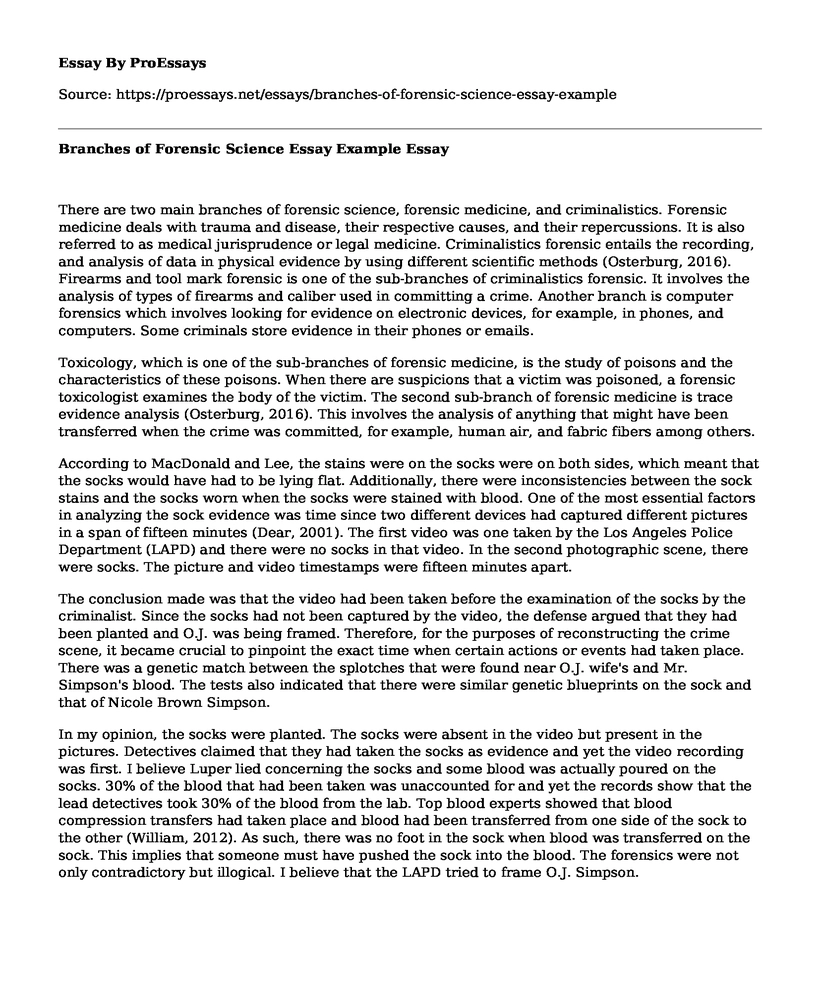There are two main branches of forensic science, forensic medicine, and criminalistics. Forensic medicine deals with trauma and disease, their respective causes, and their repercussions. It is also referred to as medical jurisprudence or legal medicine. Criminalistics forensic entails the recording, and analysis of data in physical evidence by using different scientific methods (Osterburg, 2016). Firearms and tool mark forensic is one of the sub-branches of criminalistics forensic. It involves the analysis of types of firearms and caliber used in committing a crime. Another branch is computer forensics which involves looking for evidence on electronic devices, for example, in phones, and computers. Some criminals store evidence in their phones or emails.
Toxicology, which is one of the sub-branches of forensic medicine, is the study of poisons and the characteristics of these poisons. When there are suspicions that a victim was poisoned, a forensic toxicologist examines the body of the victim. The second sub-branch of forensic medicine is trace evidence analysis (Osterburg, 2016). This involves the analysis of anything that might have been transferred when the crime was committed, for example, human air, and fabric fibers among others.
According to MacDonald and Lee, the stains were on the socks were on both sides, which meant that the socks would have had to be lying flat. Additionally, there were inconsistencies between the sock stains and the socks worn when the socks were stained with blood. One of the most essential factors in analyzing the sock evidence was time since two different devices had captured different pictures in a span of fifteen minutes (Dear, 2001). The first video was one taken by the Los Angeles Police Department (LAPD) and there were no socks in that video. In the second photographic scene, there were socks. The picture and video timestamps were fifteen minutes apart.
The conclusion made was that the video had been taken before the examination of the socks by the criminalist. Since the socks had not been captured by the video, the defense argued that they had been planted and O.J. was being framed. Therefore, for the purposes of reconstructing the crime scene, it became crucial to pinpoint the exact time when certain actions or events had taken place. There was a genetic match between the splotches that were found near O.J. wife's and Mr. Simpson's blood. The tests also indicated that there were similar genetic blueprints on the sock and that of Nicole Brown Simpson.
In my opinion, the socks were planted. The socks were absent in the video but present in the pictures. Detectives claimed that they had taken the socks as evidence and yet the video recording was first. I believe Luper lied concerning the socks and some blood was actually poured on the socks. 30% of the blood that had been taken was unaccounted for and yet the records show that the lead detectives took 30% of the blood from the lab. Top blood experts showed that blood compression transfers had taken place and blood had been transferred from one side of the sock to the other (William, 2012). As such, there was no foot in the sock when blood was transferred on the sock. This implies that someone must have pushed the sock into the blood. The forensics were not only contradictory but illogical. I believe that the LAPD tried to frame O.J. Simpson.
References
Dear, W. (2001). O.J. is guilty but not of murder. Midlothian, TX (5931 Sleepy Hollow Ln.): Dear Overseas Production.
Osterburg, J. W. (2016). Criminal investigation: A method for reconstructing the past. Place of publication not identified: Taylor & Francis.
William, C. (2012). O.J. is Innocent and I Can Prove It: The shocking truth about the murders of Nicole Simpson and Ron Goldman. New York: Sky Horse Publishing.
Cite this page
Branches of Forensic Science Essay Example. (2022, Sep 04). Retrieved from https://proessays.net/essays/branches-of-forensic-science-essay-example
If you are the original author of this essay and no longer wish to have it published on the ProEssays website, please click below to request its removal:
- Gun Control Debate Essay
- An Analysis of Walt Disney's Social Performance: Environment and Human Rights
- Paper Example on Interviews: Gather Info for Cybercrime Case, Analyze for Perpetrator
- U.S. Marijuana Use: Federal vs. State Laws - Research Paper
- Essay Example on Criminal Psychology: Essential for Criminal Justice Majors
- Paper Example on Appellant Fails to Convict of 1st Degree Murder in Supreme Court
- Correctional Institutions: Challenges in Managing Staff Members - Essay Sample







